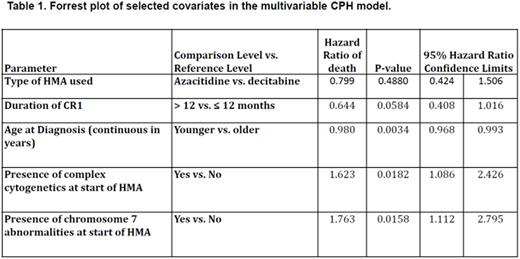Abstract

Introduction: Patients with RR-AML, particularly older adults, have dismal outcomes and limited therapy options. Given low response rates and high toxicity with salvage intensive chemotherapy, and frequent ineligibility for allogeneic stem cell transplantation (alloSCT), many patients are treated with HMAs. Robust data regarding use of HMAs in AML predominates in the frontline setting, while their use in RR-AML has limited supportive data. Here wesought to analyze theoutcomes and their predictors in patients with RR-AML treated with HMAs.
Methods:We collected data, spanning a period from 2006 to 2016, from 7 centers in the United States and 4 centers in Europe regarding patients treated with HMAs for RR-AML. Responses were defined by International Working Group criteria. Kaplan-Meier methods estimated overall survival (OS) from initiation of HMAs to death or end of follow-up. Multivariable logistic regression models estimated odds for response, and multivariable Cox Proportional Hazard (CPH) models estimated hazards ratios (HR) for OS. Covariates considered included HMA received, age at diagnosis (in years), AML classification at diagnosis (AML with myelodysplasia-related changes [AML-MRC], therapy-related [t]-AML), disease status (relapsed vs. refractory), number of therapy lines prior to HMA (1 vs. 2 vs. >=3), duration of first complete remission (CR1), white blood cell count, peripheral blood blast percentage, bone marrow (BM) cellularity (<=20% vs. > 20%), BM blast percentage (<=20% vs. >20%), cytogenetic risk group, and the presence of complex or chromosome 7 abnormalities.
Results: Of 514 patients, 217 patients (42.2%) had refractory and 297 (58%) had relapsed AML. By end of study, 415 patients (88.5%) had died. Median follow-up for living patients was 11.6 months.Median age at diagnosis was 64 years (range [R], 16-92). AML-MRC was diagnosed in 29.0% while 8.2% had t-AML. Median number of prior therapies was 2 (R, 1-7), with 48.3% receiving 1 prior line, 30.2% receiving 2 prior lines, and 21.5% receiving >=3 prior lines. Prior alloSCT was performed in 21.2%. Only 1.9% had good risk (core binding factor) karyotype, while 56.2% had intermediate risk karyotype, and 41.9% had poor risk karyotype. Azacitidine was used in 45.8% and decitabine in 54.2%; median number of azacitidine cycles was 4 (Interquartile range [IQR], 2-6) compared to 2 for decitabine (IQR, 1-4, p <0.001). Best response to HMAs was CR in 11.7% (95%CI, 9%-14%), CRi in 6.4% (95%CI, 4.3%-8.8%), hematologic improvement (HI) in 8% (95%CI, 5.7%-10.5%), stable disease (SD) in 9.8% (95%CI, 7.2%-12.5%), while 64.1% (95%CI, 57.7%-66.2%) had progressive disease (PD). Median OS from HMA initiation for all patients was 6.9 months (IQR, 3.0-13.3). There was a significant difference in OS based on best response achieved [Figure 1]. Unadjusted OS showed an insignificant trend for worsening with increasing number of prior lines of therapy [Figure 2A]. In unadjusted analyses, there was no difference in OS based on HMA received in all patients [Figure 2B] or the subset who received only 1 prior line of therapy (median OS: Azacitidine vs. decitabine 8.4 vs 7.3 months, p=0.88). Following HMA therapy, the median number of subsequent therapies was 0 (R, 0-6), and only 12.8% underwent alloSCT. In multivariate CPH models, HMA used was not significantly associated with OS (HR=0.80, 95%CI, 0.42-1.51, p=0.49), while increasing age, and presence of complex cytogenetics and chromosome 7 abnormalities were significantly associated with risk of death [Table 1]. In multivariable logistic regression models, HMA used was not associated with achieving CR+CRi (Odds ratio=0.56, p=0.32).
Conclusions: In this largest reported cohort of patients with RR-AML treated with HMAs, we found that HMAs are often used as alast line of therapy, with a minority of patients receiving subsequent treatment. Nonetheless, the minority of patients who achieve CR (11.7%) with HMA therapy had a median OS of 25.6 months. Therefore, use of HMAs for management of RR-AML is a reasonable intervention in the absence of clinical trial options. There appears to be no difference in OS or probability of achieving CR+CRi based on HMA used. Ongoing analyses in this dataset include further evaluations of predictors, including genetic mutations, and the development of prediction tools for clinical outcomes with HMA therapy.
Podoltsev:Ariad: Consultancy, Honoraria; Incyte: Consultancy, Honoraria. Ritchie:Novartis: Honoraria; Incyte: Speakers Bureau; Arian: Speakers Bureau; Pfizer: Honoraria; Celgene: Speakers Bureau. Sekeres:Millenium/Takeda: Membership on an entity's Board of Directors or advisory committees; Celgene: Membership on an entity's Board of Directors or advisory committees. Komrokji:Celgene: Membership on an entity's Board of Directors or advisory committees, Research Funding; Novartis: Consultancy, Speakers Bureau. Al-Kali:Onconova Therapeutics, Inc.: Research Funding; Celgene: Research Funding. Santini:Celgene: Consultancy, Honoraria, Research Funding; Janssen: Consultancy, Honoraria; Novartis: Consultancy, Honoraria; Onconova: Consultancy; Amgen: Consultancy; Astex: Consultancy. Roboz:Cellectis: Research Funding; Agios, Amgen, Amphivena, Astex, AstraZeneca, Boehringer Ingelheim, Celator, Celgene, Genoptix, Janssen, Juno, MEI Pharma, MedImmune, Novartis, Onconova, Pfizer, Roche/Genentech, Sunesis, Teva: Consultancy. Fenaux:Celgene, Janssen,Novartis, Astex, Teva: Honoraria, Research Funding. Prebet:celgene: Consultancy, Honoraria; Novartis: Consultancy, Honoraria. Gore:celgene: Consultancy, Honoraria. Zeidan:Ariad: Consultancy, Honoraria; Pfizer: Consultancy, Honoraria; Incyte: Consultancy, Honoraria; Celgene: Consultancy, Honoraria.
Author notes
Asterisk with author names denotes non-ASH members.

This icon denotes a clinically relevant abstract




This feature is available to Subscribers Only
Sign In or Create an Account Close Modal